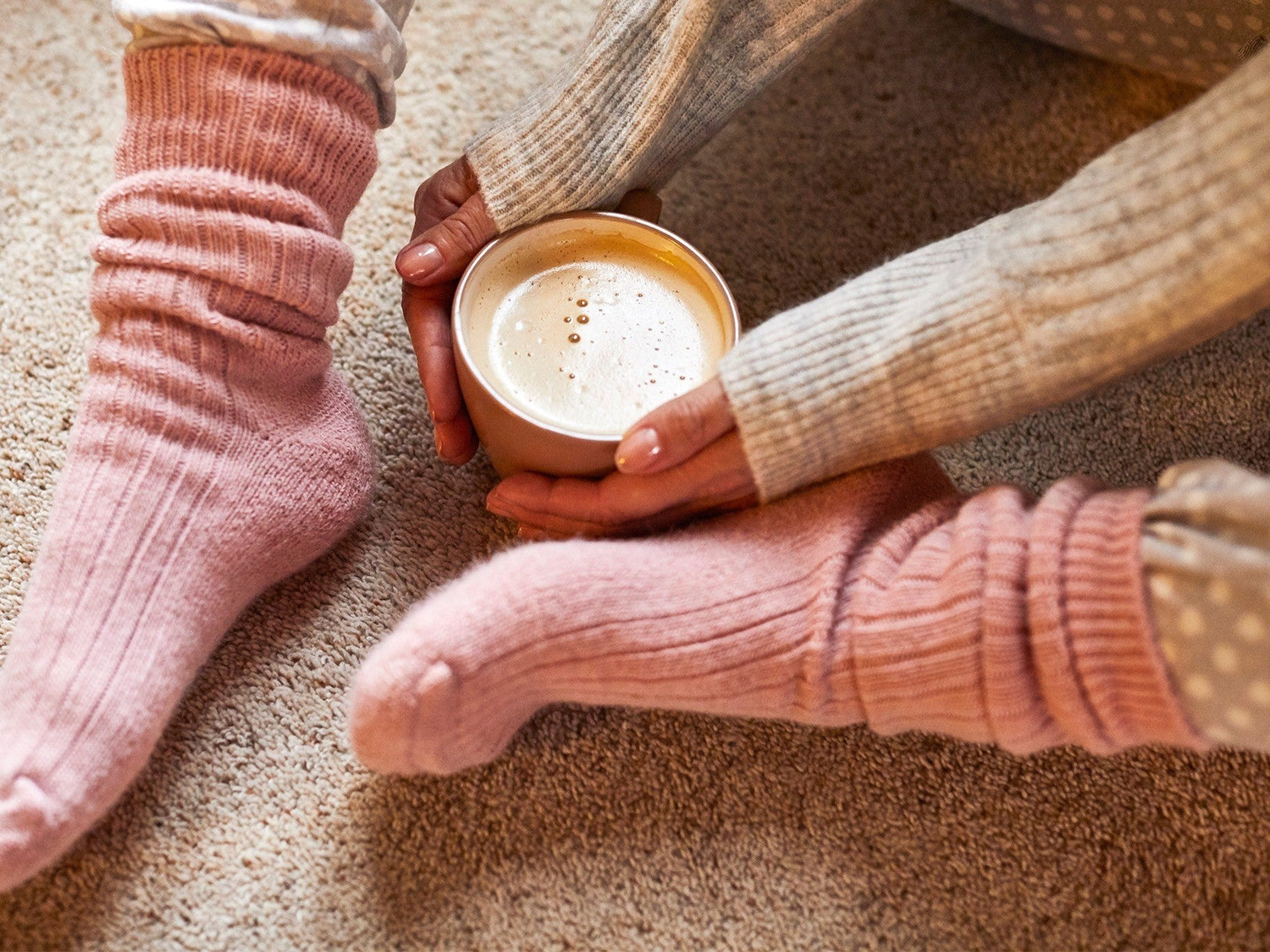
Moisture-Wicking Guide: Stay Dry and Comfortable in 2025
Imagine stepping into 2025, where staying cool and dry is effortless, whether you are powering through a workout, exploring the outdoors, or handling a hectic schedule. The secret? Moisture-wicking fabrics designed to keep you comfortable in any situation.
In this guide, you will discover the science behind moisture-wicking, how fabric technology has evolved, and which materials perform best. We will share tips to help you select the right garments, reveal breakthrough innovations for 2025, and explain how to care for your clothing to maintain peak performance.
Ready to enjoy the benefits of staying dry and confident all day? Let’s upgrade your wardrobe and embrace next-level comfort.
The Science of Moisture-Wicking: How It Keeps You Dry
Imagine stepping outside on a humid day or finishing a tough workout, yet your clothes stay comfortable and dry. That’s the power of moisture-wicking technology at work. But how does it actually keep you dry, and why is it so useful in both active and everyday life? Let’s break down the science and discover why moisture-wicking fabrics are changing the way we dress and perform.
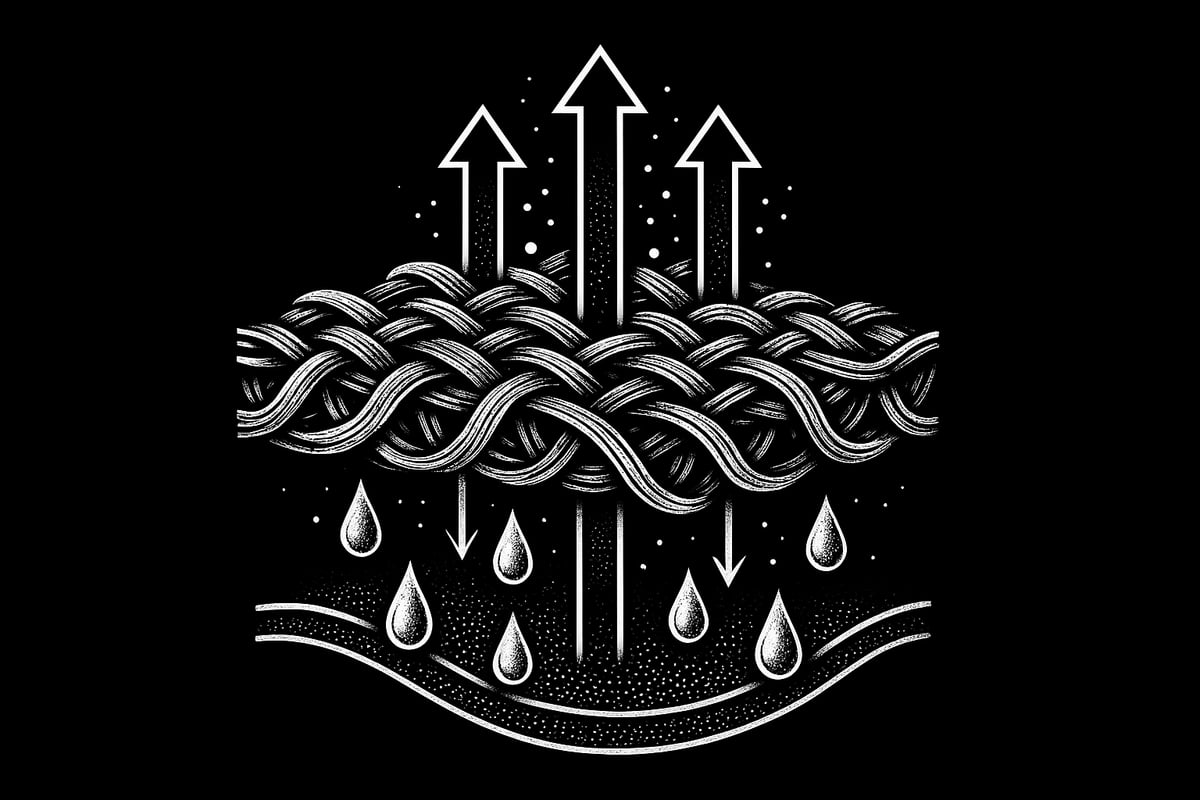
What Is Moisture-Wicking?
Moisture-wicking refers to a fabric’s ability to pull sweat away from your skin and move it to the outer surface, where it can evaporate quickly. The main purpose is to keep you dry and comfortable, especially during physical activity or in warm, humid environments.
Unlike absorbent fabrics, which soak up moisture and hold it close to your body, moisture-wicking materials are designed to transfer sweat efficiently. This helps prevent that sticky, heavy feeling you get when wearing cotton after a workout.
A common misconception is that all athletic fabrics are moisture-wicking. In reality, only specific fibers and weaves offer true wicking performance. You’ll notice moisture-wicking in action when your running shirt dries quickly after a jog, or when your hiking socks keep your feet comfortable on a long trek. For anyone with an active lifestyle or a busy day, this feature is a game-changer.
The Physics: Capillary Action and Evaporation
The secret behind moisture-wicking lies in physics. Synthetic and natural fibers use capillary action, a process where tiny channels within the fabric pull moisture away from the skin. The sweat travels through these microscopic gaps until it reaches the fabric’s surface.
Once there, evaporation takes over. The moisture spreads out, increasing its surface area and allowing it to dry faster. The diameter of the fibers and the way they are woven play a huge role in efficiency. For example, synthetic fibers like polyester can wick up to 50 percent more moisture than cotton, making them ideal for performance wear.
Recent research, such as the Sweat Drying Performance of Thermal Fabrics, highlights how fabric structure and engineering can dramatically improve wicking and drying rates. Choosing the right moisture-wicking fabric means you benefit from the latest advances in textile science.
Key Benefits Beyond Dryness
Moisture-wicking fabrics do more than just keep you dry. They help regulate your body temperature by speeding up evaporation, which provides a cooling effect when you’re hot. Many wicking materials are also treated to control odor, so you stay fresh even after hours of wear.
By reducing the amount of moisture trapped against your skin, these fabrics help prevent chafing and irritation. For athletes, comfort is key, and studies show that up to 30 percent of athletes report improved comfort when wearing moisture-wicking gear.
Here’s a quick look at the main benefits:
| Benefit | Impact |
|---|---|
| Temperature regulation | Cooling effect during activity |
| Odor control | Better hygiene, lasting freshness |
| Less chafing/irritation | Improved comfort, fewer rashes |
| Athletic performance | Up to 30% more comfort (Under Armour) |
Common Myths and Facts
There are plenty of myths about moisture-wicking fabrics. Some believe all sportswear is moisture-wicking, but only certain weaves and fibers deliver real results. It’s also a myth that cotton is good for sweat management. In fact, cotton holds onto moisture, which can make you feel cold and clammy.
Let’s compare: After a gym session, a cotton shirt will be heavy and damp, while a polyester shirt will feel lighter and drier. This difference is due to how each material handles sweat.
The fact is, for true moisture-wicking, look for labels that specify performance fabrics. Don’t let marketing claims fool you—check the fiber content and construction for proof.
Who Needs Moisture-Wicking Most?
Who can benefit most from moisture-wicking clothing? Athletes and outdoor enthusiasts rely on these fabrics to stay comfortable during intense activity. Commuters, healthcare workers, and anyone in humid climates also appreciate the dry feel.
People who sweat heavily, as well as children and the elderly, find extra comfort in moisture-wicking garments. According to a recent survey, 68 percent of gym-goers prefer moisture-wicking apparel for their workouts. No matter your routine, choosing moisture-wicking clothing can help you stay dry, confident, and comfortable all day.
The Evolution of Moisture-Wicking Fabrics
The journey of moisture-wicking fabrics has been a story of constant innovation, driven by the need for comfort and performance. From the earliest sportswear experiments to the high-tech textiles of today, each era has brought new materials and smarter design. Let’s break down how the landscape has changed, making it easier than ever to stay dry and comfortable.
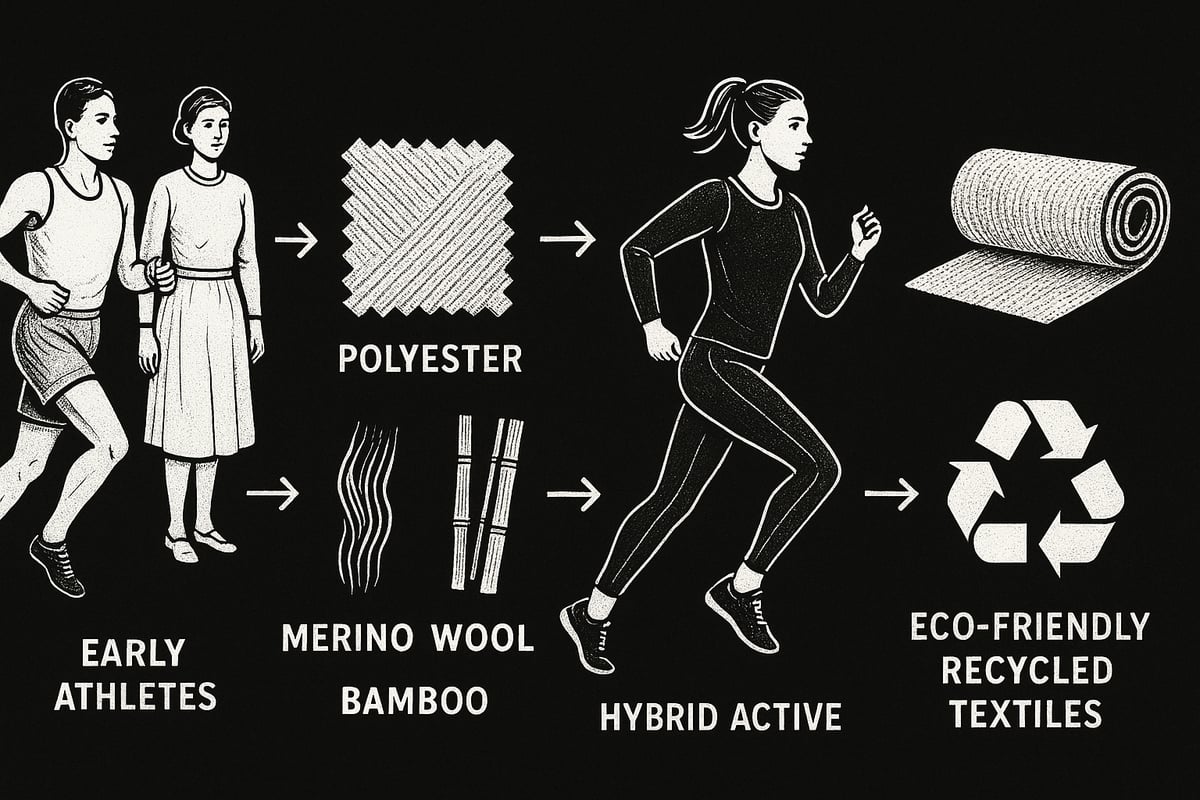
Early Innovations and Synthetic Breakthroughs
Moisture-wicking technology began gaining traction in the 1970s and 1980s, as athletes sought alternatives to heavy, sweat-soaked cotton. The introduction of synthetic fibers like polyester and nylon marked a turning point. These materials offered a lightweight, quick-drying solution that moved sweat away from the skin.
Brands like Nike and Under Armour pioneered signature moisture-wicking lines, such as Dri-FIT and HeatGear. While early versions excelled at pulling moisture from the skin, they sometimes sacrificed comfort and breathability. Over time, advances in fiber engineering and fabric construction addressed these limitations, setting the stage for the next generation of activewear.
Natural Fibers Enter the Scene
As the demand for sustainable and skin-friendly options grew, natural fibers joined the moisture-wicking conversation. Merino wool emerged as a standout, prized for its ability to regulate temperature and resist odors. Bamboo and modal also gained popularity, offering breathability and softness.
Unlike traditional wool, merino can absorb up to 30% of its weight in moisture and still feel dry, making it ideal for hiking and everyday wear. For a closer look at how merino excels, see the Benefits of merino wool socks. These natural fibers often outperform synthetics in comfort, especially for sensitive skin.
Fabric Blends and Hybrid Technologies
As the world of moisture-wicking evolved, brands began blending synthetic and natural fibers to capture the strengths of both. Polyester-merino mixes, bamboo-spandex blends, and poly-cotton combinations became common in activewear.
These hybrid fabrics offer enhanced breathability, improved stretch, and a softer touch. They are also more durable and versatile, suiting a wide range of activities from running to yoga. In 2025, customizable blends are trending, letting you match your garment’s properties to your specific needs.
Comparison Table: Hybrid Blends
| Blend Type | Key Benefit | Common Use |
|---|---|---|
| Polyester-Merino | Odor resistance | Base layers |
| Bamboo-Spandex | Stretch & comfort | Yoga wear |
| Poly-Cotton | Breathability | Everyday shirts |
Advancements in Weaving and Finishing
Modern moisture-wicking fabrics are no longer just about the material—they’re about how it’s made. The rise of microfiber and nanofiber technology has created textiles with ultra-fine channels for rapid sweat transport.
Innovations like 3D knitting and seamless construction allow for targeted moisture zones, while chemical finishes can lock in wicking performance wash after wash. For example, today’s running shirts are lighter, drier, and more comfortable than those from just a decade ago, thanks to these advances in weaving and finishing.
Sustainability in Moisture-Wicking Fabrics
Eco-conscious consumers are driving a shift toward greener moisture-wicking solutions. Brands now use recycled synthetics, such as polyester from plastic bottles, and develop biodegradable options for reduced environmental impact.
Initiatives like Nike’s Move to Zero and Under Armour’s recycled lines help meet growing demand for ethical activewear. In fact, 54% of buyers prefer sustainable performance gear. The future is bright for moisture-wicking fabrics that offer both high performance and a lighter footprint on the planet.
Top Moisture-Wicking Materials for 2025
Staying dry and comfortable in 2025 starts with choosing the right moisture-wicking materials. The market now offers a diverse range of fabrics, each with unique benefits and innovations. Understanding these options can help you select the ideal garment for your activity, climate, and comfort needs.
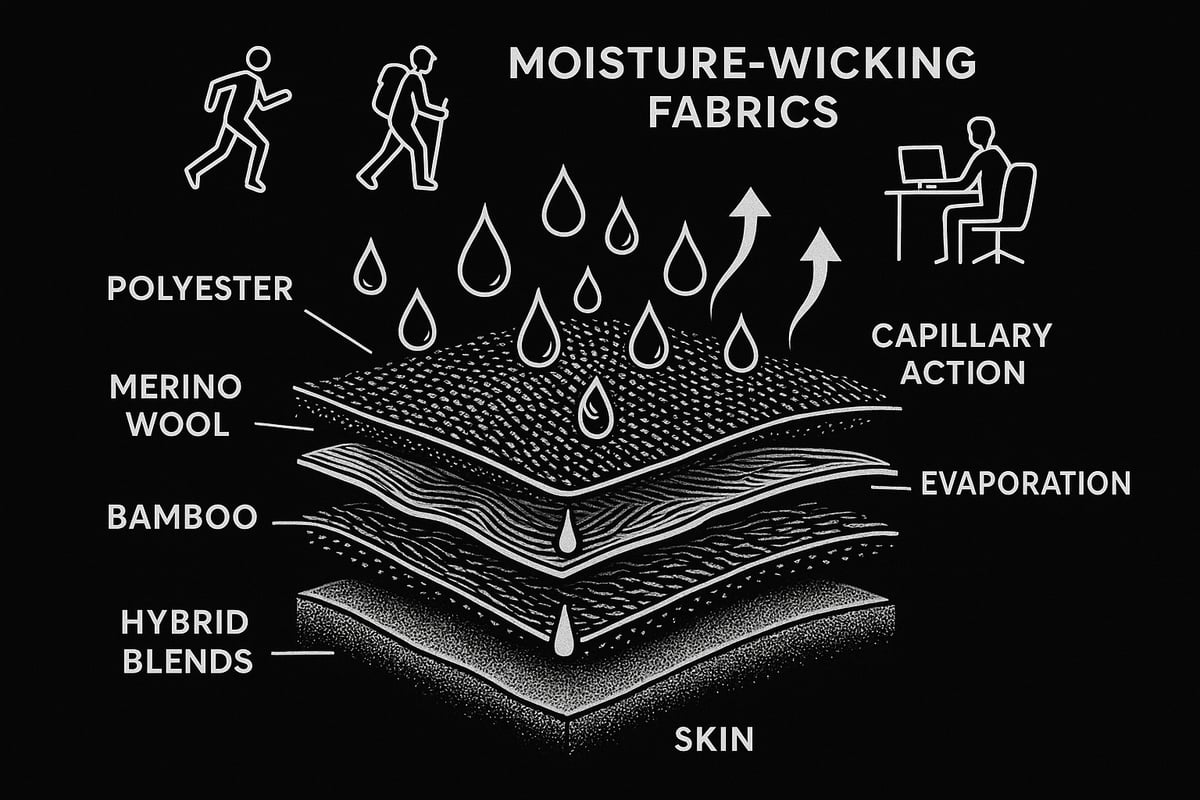
Synthetic Superstars: Polyester, Nylon, and Beyond
Synthetic fibres remain the backbone of modern moisture-wicking technology. Polyester and nylon are the most popular, prized for their fast-drying, lightweight, and durable qualities. These fabrics use specialized cross-section fibres and hydrophobic coatings to draw sweat away from the skin and speed up evaporation.
For high-intensity sports, gym sessions, or as base layers, synthetics deliver unmatched performance. Iconic products like Nike Dri-FIT and Under Armour HeatGear are built on advanced polyester blends. Studies show that polyester wicks moisture 50% faster than cotton, making it a top pick for anyone seeking reliable moisture-wicking in activewear.
Innovations in 2025 include micro-engineered fibres that increase the surface area for evaporation, ensuring you stay cool even during peak exertion. If you need gear that dries quickly and lasts through countless workouts, synthetic moisture-wicking fabrics are a smart investment.
Natural Champions: Merino Wool, Bamboo, and Tencel
Natural fibres have made a remarkable leap in moisture-wicking technology. Merino wool stands out for its temperature regulation and odor resistance, making it perfect for hiking, travel, and everyday use. It can absorb up to 30% of its weight in moisture while still feeling dry to the touch.
Bamboo is another rising star, offering breathability, hypoallergenic properties, and sustainability. Tencel, derived from wood pulp, is soft, eco-friendly, and excels at moving moisture away from the skin. These natural fibres are gentle on sensitive skin and suitable for warm climates.
For a deeper look at how natural moisture-wicking fibres keep you cool in the heat, check out Natural fibre socks for summer. Whether you are trekking rugged trails or navigating daily commutes, natural moisture-wicking materials offer comfort and eco-conscious benefits.
Hybrid and Blended Fabrics
Hybrid and blended fabrics combine the strengths of synthetic and natural fibres, creating moisture-wicking garments that balance comfort, stretch, and performance. Common blends include polyester-merino and bamboo-spandex, offering enhanced breathability and durability.
These blends are especially popular in 2025's activewear, where customizable fabric recipes cater to specific activities. For example, a polyester-merino blend might be ideal for hikers needing both moisture-wicking and softness, while a poly-cotton mix suits casual wear.
The main advantage of hybrid fabrics is their versatility. While they may not match pure synthetics for speed of drying, they often provide a softer feel and better temperature regulation. Consider your priorities—durability or comfort—when choosing a blended moisture-wicking garment.
Fabric Innovations to Watch in 2025
The future of moisture-wicking is bright, with new technologies reshaping how we stay dry. Smart textiles are emerging, featuring embedded sensors that monitor sweat and temperature in real time, sending data to your smartphone. This innovation is especially valuable for athletes seeking to optimize performance.
Advanced antimicrobial and anti-odor treatments are also on the rise, using silver ions or plant-based solutions to keep clothes fresher longer. UV-protective and cooling technologies are integrated into fabrics, offering extra protection and comfort during outdoor activities.
Top brands are launching garments with modular designs, allowing users to adjust ventilation zones or layer adaptively. These breakthroughs ensure that moisture-wicking gear in 2025 is not just functional but tailored to your needs.
Choosing the Right Material for Your Needs
Selecting the best moisture-wicking fabric depends on your activity, climate, and personal preferences. Use the quick-reference chart below to match materials to your lifestyle:
| Activity | Best Material | Key Benefit |
|---|---|---|
| Running | Polyester/Nylon | Fast drying |
| Hiking | Merino Wool/Blends | Temperature control |
| Office/Travel | Bamboo/Tencel | Softness, eco-friendly |
| Everyday Wear | Hybrid Blends | Comfort, versatility |
One size never fits all, so consider how much you sweat, your skin sensitivity, and your style preferences. For a marathon runner, synthetic moisture-wicking gear is a must, while an office commuter might prefer the softness of bamboo or Tencel.
Remember, matching your moisture-wicking material to your specific needs ensures you stay comfortable, dry, and confident—no matter what your day brings.
How to Choose Moisture-Wicking Garments: A Step-by-Step Guide
Choosing the perfect moisture-wicking garment can feel overwhelming with so many options in 2025. This step-by-step guide will help you cut through the confusion and find exactly what suits your needs. Whether you’re a gym regular, an outdoor adventurer, or just want to stay dry at work, follow these steps to make the smartest choice.
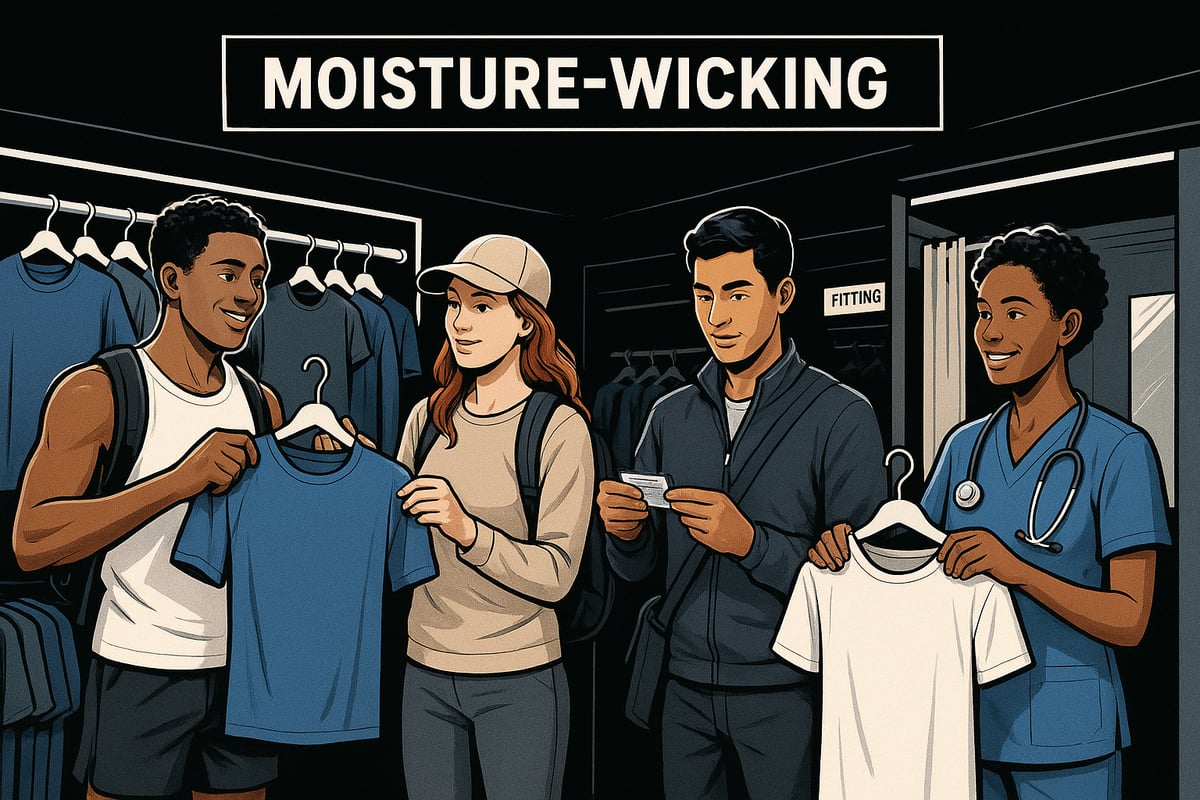
Step 1: Assess Your Activities and Needs
Start by thinking about when and where you’ll wear your moisture-wicking clothing. Are you running marathons, hiking rugged trails, commuting in humid cities, or need something for everyday office wear?
- Identify your primary activity
- Consider how much you sweat and your local climate
- Think about your comfort preferences
Matching your moisture-wicking gear to your lifestyle ensures optimal performance. For example, a gym-goer will benefit from lightweight, quick-drying tops, while a hiker might need moisture-wicking socks and base layers for longer adventures.
Step 2: Understand Fabric Labels and Certifications
Reading labels is crucial when shopping for moisture-wicking garments. Look for terms like “moisture-wicking,” “quick-dry,” or “performance.” These indicate that the item is designed to manage sweat effectively.
- Certifications such as OEKO-TEX and Bluesign mean the fabric meets safety and environmental standards.
- Check the fiber content: polyester, nylon, merino wool, bamboo, and Tencel are common moisture-wicking materials.
- Be wary of marketing buzzwords that don’t specify actual performance features.
Knowing what’s behind the label helps you invest in genuine moisture-wicking apparel instead of falling for hype.
Step 3: Evaluate Fit, Construction, and Comfort
The fit of your moisture-wicking garment plays a big role in how well it works. A shirt that’s too tight can restrict movement, while one that’s too loose may not wick sweat efficiently.
Look for these construction features:
- Flatlock seams to prevent chafing
- Mesh panels for added airflow
- Gussets for improved mobility
When trying on clothes, move around to check for comfort. Compare two running shirts: one with strategic mesh and seamless construction, and another with basic stitching. The difference in feel and moisture-wicking performance will be clear.
Step 4: Prioritize Breathability and Layering
Effective moisture-wicking is about more than just fabric—it’s also about how you wear it. Breathable zones and ventilation panels boost comfort, especially during intense activity or in hot weather.
Layering is key. Use a moisture-wicking base layer, a breathable mid-layer, and a protective outer layer for maximum effect. Research on the Drying Performance of Fabrics on the Human Body shows that strategic layering can increase moisture management by up to 40 percent.
Choose garments that let your skin breathe and allow sweat to evaporate efficiently.
Step 5: Consider Style, Durability, and Price
Moisture-wicking clothing now comes in a range of styles, from bold patterns to classic neutrals. Pick something that fits your taste and lifestyle.
- Look for durable fabrics with lasting wicking properties
- Balance your budget with garment quality
- Invest in key pieces like a high-quality base layer, rather than fast fashion items
A good moisture-wicking garment holds up after multiple washes and continues to keep you comfortable.
Step 6: Try, Test, and Adjust
Personal comfort is the ultimate test for moisture-wicking apparel. Try garments at home or in-store—move, stretch, and check for any irritation.
- Test in real conditions: wear your gear to the gym, on a hike, or during a typical workday
- Adjust your wardrobe based on what works best
- Read reviews and ask for feedback from others who value moisture-wicking clothing
Remember, finding the right fit may take a little experimentation, but the reward is all-day dryness and comfort.
Breakthrough Innovations in Moisture-Wicking for 2025
The year 2025 is redefining how we stay dry, thanks to a wave of breakthrough moisture-wicking technologies. If you thought your gym shirt or hiking socks were advanced, get ready to discover a world where textiles are smarter, more sustainable, and more stylish than ever. Here’s what’s leading the charge.
Smart Fabrics and Wearable Tech
Moisture-wicking fabrics are getting smarter in 2025. Imagine workout shirts that monitor your sweat and body temperature, then send real-time alerts to your phone for optimal hydration and performance. Thanks to embedded sensors and AI-driven design, these garments are transforming personal comfort.
Innovations like skin-like fabric for moisture management are setting the pace, offering a second-skin feel and precise sweat control. The Moisture-Wicking Fabrics Market Report 2025 predicts a 20 percent rise in smart textile adoption, making these advancements accessible to more people every year.
Next-Gen Sustainable Materials
Sustainability is now at the heart of moisture-wicking innovation. New materials crafted from recycled ocean plastics and plant-based synthetics are making a splash. These next-gen fabrics are engineered to be both high-performing and eco-friendly, breaking down naturally at the end of their lifecycle.
Brands like Adidas and Patagonia are launching collections in 2025 that feature biodegradable moisture-wicking options. This shift is reducing the carbon footprint of athletic wear and responding to growing consumer demand for sustainable choices. Look for labels highlighting recycled content and compostable features.
Advanced Odor and Bacteria Control
Long-lasting freshness is a major goal for moisture-wicking clothing in 2025. Advanced fibers infused with silver ions or copper deliver permanent antimicrobial protection, stopping odor-causing bacteria before they start. This means you can wear your favorite performance gear longer without worrying about unwanted smells.
Under Armour’s latest anti-odor technology is a standout, combining moisture-wicking power with bacteria-fighting properties. The result is less frequent washing, more comfort, and garments that stay fresher between workouts or outdoor adventures.
Customizable and Adaptive Clothing
Personalization is taking center stage in moisture-wicking apparel. New adaptive designs feature adjustable ventilation zones and modular layers that respond to your sweat levels and environment. Some brands are even using AI to tailor fit and performance to your unique body shape and activity.
Consumers can now demand more from their wardrobe, with options that let you tweak breathability and comfort on the go. This trend is especially popular among athletes and outdoor enthusiasts seeking clothing that adapts as quickly as they do.
Fashion Meets Function: Style Trends
Style is no longer sacrificed for performance. The moisture-wicking revolution in 2025 is blending high-tech fabrics with the latest fashion trends. Athleisure continues to dominate, with designer collaborations bringing bold colors, patterns, and new silhouettes to everyday wear.
According to recent data, 62 percent of shoppers want their activewear to look as good as it feels. Expect to see moisture-wicking technology in everything from sleek office attire to statement-making streetwear, making comfort and style a package deal.
Care and Maintenance: Maximizing Moisture-Wicking Performance
Keeping your moisture-wicking gear in top shape is key to enjoying peak comfort and performance. With the right care, these advanced fabrics will keep you dry, cool, and fresh for years, whether you’re hitting the gym or exploring the outdoors.
Washing and Drying Best Practices
Washing moisture-wicking clothing properly prevents buildup of sweat, oils, and residue that can clog fibers. Always use a gentle cycle and mild detergent. Avoid fabric softeners as they can block the channels that move moisture away from your skin.
Air drying is best for moisture-wicking garments. If you must use a dryer, opt for a low heat setting. High temperatures can damage technical fibers and reduce their effectiveness. Check manufacturer care tags for specific instructions, as brands like Nike and Under Armour provide garment-specific advice.
Quick tips table:
| Do | Don't |
|---|---|
| Use mild detergent | Use fabric softener |
| Wash in cold water | Wash on hot cycle |
| Air dry when possible | Over-dry in machine |
Preserving Wicking and Odor-Resistant Properties
To maintain the moisture-wicking and odor-fighting features, wash your gear soon after use to prevent bacteria buildup. Some garments have antimicrobial treatments, so avoid harsh chemicals that might strip these properties.
If you’re caring for natural fiber socks or garments, special attention is needed to protect their wicking ability and longevity. For detailed guidance, check out How to care for natural fibre socks for expert tips.
Watch for signs your moisture-wicking gear is losing effectiveness, such as lingering odors or damp spots that don’t dry quickly. This can mean it’s time for a deep clean or replacement.
Storage and Everyday Use Tips
Proper storage is essential for preserving moisture-wicking performance. Always store clean, dry garments in a cool, ventilated space to prevent mildew and odor. Avoid stuffing damp clothes into bags or drawers.
Rotate your moisture-wicking apparel to extend its lifespan. When traveling or on outdoor adventures, pack gear in breathable bags and separate clean items from worn ones. For multi-day trips, hang socks and shirts to air out overnight.
Keeping your gear fresh between wears ensures lasting comfort and reliability.
Troubleshooting Common Issues
If your moisture-wicking clothing stops working well, first check for detergent or softener buildup. A vinegar rinse can sometimes restore performance by clearing blocked fibers. Persistent odors may require a specialty sports wash.
Repair snags or seam issues promptly to prevent further damage. For stubborn problems, such as recurring smells or loss of stretch, consult a professional cleaner who understands technical fabrics.
Knowing when to replace your moisture-wicking gear is important. If washing and repairs do not restore performance, it’s likely time for an upgrade.
Eco-Friendly Disposal and Recycling
When your moisture-wicking garments reach the end of their life, consider eco-friendly options for disposal. Many brands offer recycling or take-back programs for performance fabrics. You can also repurpose old clothing as cleaning cloths or insulation.
For socks and other small items, look for textile recycling bins in your area. Interested in the bigger picture of sustainable choices? Learn more about why ethical, sustainable socks matter in the long run by reading Why ethical sustainable socks matter.
Currently, only about 15 percent of textiles are recycled, so every effort helps reduce waste and supports a greener future for moisture-wicking apparel.
